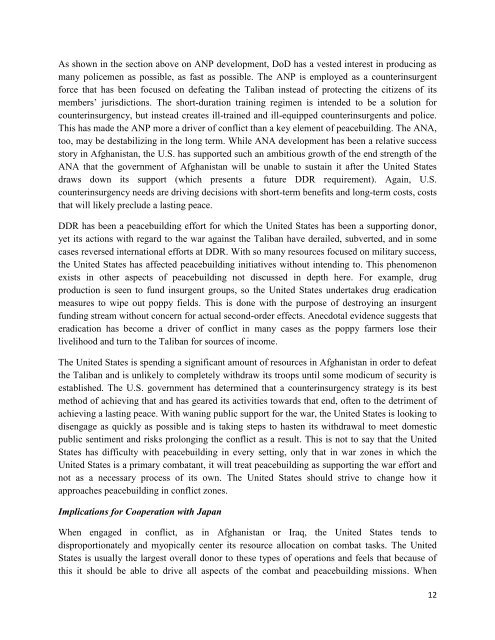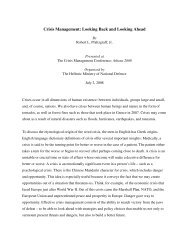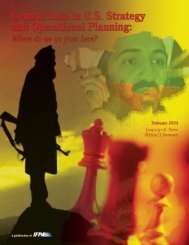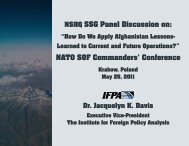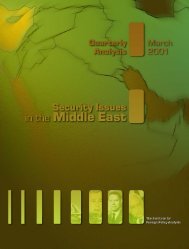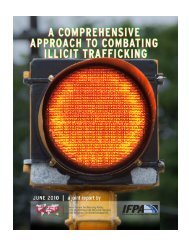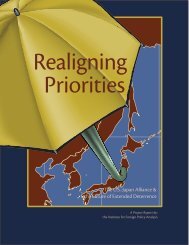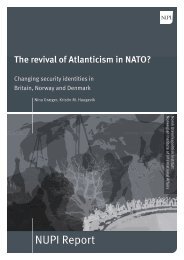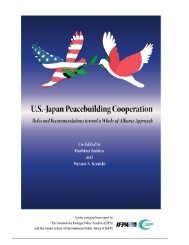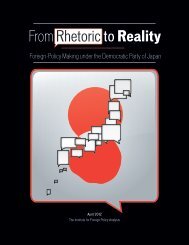US Peacebuilding in Afghanistan - Institute for Foreign Policy Analysis
US Peacebuilding in Afghanistan - Institute for Foreign Policy Analysis
US Peacebuilding in Afghanistan - Institute for Foreign Policy Analysis
You also want an ePaper? Increase the reach of your titles
YUMPU automatically turns print PDFs into web optimized ePapers that Google loves.
As shown <strong>in</strong> the section above on ANP development, DoD has a vested <strong>in</strong>terest <strong>in</strong> produc<strong>in</strong>g asmany policemen as possible, as fast as possible. The ANP is employed as a counter<strong>in</strong>surgent<strong>for</strong>ce that has been focused on defeat<strong>in</strong>g the Taliban <strong>in</strong>stead of protect<strong>in</strong>g the citizens of itsmembers’ jurisdictions. The short-duration tra<strong>in</strong><strong>in</strong>g regimen is <strong>in</strong>tended to be a solution <strong>for</strong>counter<strong>in</strong>surgency, but <strong>in</strong>stead creates ill-tra<strong>in</strong>ed and ill-equipped counter<strong>in</strong>surgents and police.This has made the ANP more a driver of conflict than a key element of peacebuild<strong>in</strong>g. The ANA,too, may be destabiliz<strong>in</strong>g <strong>in</strong> the long term. While ANA development has been a relative successstory <strong>in</strong> <strong>Afghanistan</strong>, the U.S. has supported such an ambitious growth of the end strength of theANA that the government of <strong>Afghanistan</strong> will be unable to susta<strong>in</strong> it after the United Statesdraws down its support (which presents a future DDR requirement). Aga<strong>in</strong>, U.S.counter<strong>in</strong>surgency needs are driv<strong>in</strong>g decisions with short-term benefits and long-term costs, coststhat will likely preclude a last<strong>in</strong>g peace.DDR has been a peacebuild<strong>in</strong>g ef<strong>for</strong>t <strong>for</strong> which the United States has been a support<strong>in</strong>g donor,yet its actions with regard to the war aga<strong>in</strong>st the Taliban have derailed, subverted, and <strong>in</strong> somecases reversed <strong>in</strong>ternational ef<strong>for</strong>ts at DDR. With so many resources focused on military success,the United States has affected peacebuild<strong>in</strong>g <strong>in</strong>itiatives without <strong>in</strong>tend<strong>in</strong>g to. This phenomenonexists <strong>in</strong> other aspects of peacebuild<strong>in</strong>g not discussed <strong>in</strong> depth here. For example, drugproduction is seen to fund <strong>in</strong>surgent groups, so the United States undertakes drug eradicationmeasures to wipe out poppy fields. This is done with the purpose of destroy<strong>in</strong>g an <strong>in</strong>surgentfund<strong>in</strong>g stream without concern <strong>for</strong> actual second-order effects. Anecdotal evidence suggests thateradication has become a driver of conflict <strong>in</strong> many cases as the poppy farmers lose theirlivelihood and turn to the Taliban <strong>for</strong> sources of <strong>in</strong>come.The United States is spend<strong>in</strong>g a significant amount of resources <strong>in</strong> <strong>Afghanistan</strong> <strong>in</strong> order to defeatthe Taliban and is unlikely to completely withdraw its troops until some modicum of security isestablished. The U.S. government has determ<strong>in</strong>ed that a counter<strong>in</strong>surgency strategy is its bestmethod of achiev<strong>in</strong>g that and has geared its activities towards that end, often to the detriment ofachiev<strong>in</strong>g a last<strong>in</strong>g peace. With wan<strong>in</strong>g public support <strong>for</strong> the war, the United States is look<strong>in</strong>g todisengage as quickly as possible and is tak<strong>in</strong>g steps to hasten its withdrawal to meet domesticpublic sentiment and risks prolong<strong>in</strong>g the conflict as a result. This is not to say that the UnitedStates has difficulty with peacebuild<strong>in</strong>g <strong>in</strong> every sett<strong>in</strong>g, only that <strong>in</strong> war zones <strong>in</strong> which theUnited States is a primary combatant, it will treat peacebuild<strong>in</strong>g as support<strong>in</strong>g the war ef<strong>for</strong>t andnot as a necessary process of its own. The United States should strive to change how itapproaches peacebuild<strong>in</strong>g <strong>in</strong> conflict zones.Implications <strong>for</strong> Cooperation with JapanWhen engaged <strong>in</strong> conflict, as <strong>in</strong> <strong>Afghanistan</strong> or Iraq, the United States tends todisproportionately and myopically center its resource allocation on combat tasks. The UnitedStates is usually the largest overall donor to these types of operations and feels that because ofthis it should be able to drive all aspects of the combat and peacebuild<strong>in</strong>g missions. When12


